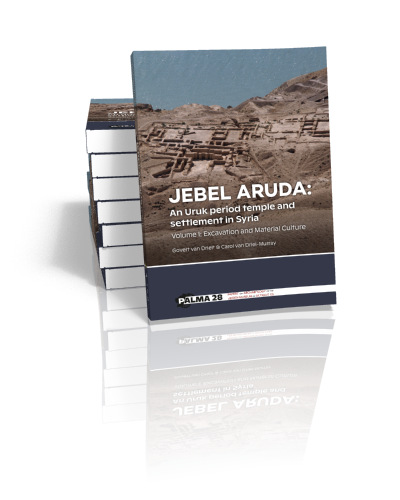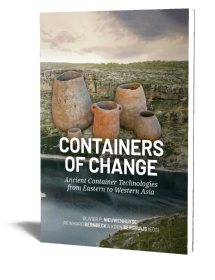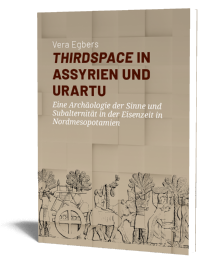Jebel Aruda: An Uruk period temple and settlement in Syria (Volume I)
Excavation and Material Culture
Govert van Driel† & Carol van Driel-Murray | 2023

Jebel Aruda: An Uruk period temple and settlement in Syria (Volume I)
Excavation and Material Culture
Govert van Driel† & Carol van Driel-Murray | 2023
Paperback ISBN: 9789464261707 | Hardback ISBN: 9789464261714 | Imprint: Sidestone Press | Format: 210x280mm | 390 pp. | Papers on Archaeology of the Leiden Museum of Antiquities 28a | Series: PALMA | Language: English | 385 illus. (bw) | 112 illus. (fc) | Keywords: Near-Eastern archaeology; Syria; Uruk period; temple; domestic architecture; material culture | download cover | DOI: 10.59641/mch0f9df
Read online 803 times
- Digital & Online access
-
Buy via Sidestone (EU & UK)
-
Buy via our Distributors (WORLD)
For non-EU or UK destinations you can buy our books via our international distributors. Although prices may vary this will ensure speedy delivery and reduction in shipping costs or import tax. But you can also order with us directly via the module above.
UK international distributor
USA international distributor
-
Bookinfo
Paperback ISBN: 9789464261707 | Hardback ISBN: 9789464261714 | Imprint: Sidestone Press | Format: 210x280mm | 390 pp. | Papers on Archaeology of the Leiden Museum of Antiquities 28a | Series: PALMA | Language: English | 385 illus. (bw) | 112 illus. (fc) | Keywords: Near-Eastern archaeology; Syria; Uruk period; temple; domestic architecture; material culture | download cover | DOI: 10.59641/mch0f9df
Read online 803 times

We will plant a tree for each order containing a paperback or hardback book via OneTreePlanted.org.
Jebel Aruda, a prominent mountain ridge overlooking the Tabqa Dam lake in northern Syria, was the location of a remarkable settlement that flourished between c. 3300 and 3100 BC during the so-called Uruk period. For the inhabitants the sacredness of this high place, evidenced by the discovery of a large temple complex, seems to have taken precedent over its impractical location far above the valley of the Euphrates River. The site was destroyed under unknown circumstances, leaving behind the spectacular remains of a well preserved temple complex and numerous houses filled with a rich collection of material culture and administrative tools such as bullae and tablets.
A Dutch team excavated the site between 1972 and 1982 while the Tabqa Dam was under construction. These two volumes present the results of these excavations and subsequent research of the remains, with special emphasis on the relationship between the domestic architecture and the finds.
These richly illustrated volumes aim to facilitate further research and analysis of an exceptional, short-lived Uruk period settlement, comprising domestic architecture associated with a monumental temple complex. It is intended to appeal to readers interested in Mesopotamia and ancient Syria, as well as archaeologists concerned with architectural and locational analysis in a broader perspective.
Volume I presents the results of the excavation, with a discussion of the individual houses and the history of the temple buildings, together with the pottery corpus, the administrative artefacts and sealings, as well as shorter chapters on other material categories (flint, stone etc). The contents of each individual house are presented in Volume II.
VOLUME I: TEXT
I Preface C. van Driel-Murray
II Foreword
III Explanatory notes to the text and illustrations, conventions and abbreviations
IV Previous publications
1 The Site and its Exploration
1.1 The site and its setting
1.2 Access
1.3. Site configuration
1.4 The nature of the settlement
1.5 Periodization
1.6 Destruction and later activity
1.7 The Recent House
1.8 Excavation
2 The Temple Area
2.1 Outline of developments
2.2 The course of the excavation
2.3 The preparations for building
2.4 Phase I: The surroundings of the Red Temple
2.5 Phase I: The Red Temple
2.6. Phase II: The Grey Temple
2.7 The second kitchen
2.8. Phase III: The Third Terrace
2.9 Later features: graves
2.10 Reconstructions
3 The site and the temples: aspects of architecture and urban planning. D.E. Boas-Vedder
4 The Houses to the North of the Temples
4.1 Introduction, course of the excavation, phasing
4.2 Public spaces
4.3 House NA
4.4 House NB
4.5 House NC
4.6 House ND/NE
4.7 House NF
4.8 House NG
4.9 House NH
4.10 Conclusions
4.11 Northern houses room inventory diagrams
5 The Saddle with Houses SI, SII and SIII
5.1 General aspects
5.2 House SI
5.3 House SII
5.4 House SIII
6 The Area at the Foot of the High Terrace: Houses SIVA, SIVB, SVIII and the Kitchen Area SIVC
6.1 General aspects
6.2 House SIVA
6.3 House SIVB
6.4 The kitchen area SIVC
6.5 House SVIII
6.6 The pits
7 The High Terrace: Houses SVA, SVB, SVI and SVII
7.1 General aspects
7.2 House SVB
7.3 House SVA
7.4 House SVI
7.5 House SVII
7.6 Southern houses conclusion
7.7 Southern houses room inventory diagrams
8 The Pottery Corpus
8.1 Categorisation of vessel forms, technology and volumes
8.2 The pottery categories Cats 1-44
8.3 Pot marks
9 Administrative Artefacts: Tablets, Tokens, Seals and Sealings
9.1 Tablets
9.2 Tokens and bullae
9.3 Seals and sealings
9.4 Actual seals
9.5 Seals reconstructed from clay sealings
10 The Flaked Stone Assemblage at Jebel Aruda
10.1 The 1982 assemblage. J. Hanbury-Tenison
10.2 Additional notes concerning the flint from other seasons
11 Summary Analysis of Botanical and Faunal Samples
11.1 Botanical remains
11.2 Zoological analysis
11.3 Shells
11.4 Diatom analysis of sherds. M.J. Jansma
12 Miscellaneous Artefacts
12.1 Jar stoppers, clay lids and other clay objects
12.2 Disk-shaped objects and spindle whorls of clay or stone
12.3 Stone vessels
12.4 Basalt saddle querns
12.5 Stone weights
12.6 Natural stone implements
12.7 Bitumen
12.8 Metal
12.9 Bone tools and artefacts
12.10 Beads and ornaments
12.11 Other special objects, figurines, models, faience
13 Evidence for Craft Production and Processing
13.1 Food and food processing
13.2 Manufacturing
14 General Observations on the Domestic Complexes
14.1 Introduction
14.2 Dimensions
14.3 Hearths
14.4 Entry
14.5 Reception rooms
14.6 Sanitation
14.7 Storage capacity of the houses
15 Conclusions
15.1 The limits of the investigation: before and after the settlement
15.2 After the fire
15.3 Before the main phase
15.4 Observations and interpretations
15.5 ‘Facts’
15.6 Summary
16 Bibliography
17 Appendix 1: Collected Sections
18 Appendix 2: Room Summaries
19 Appendix 3: Sherd Counts
19.1 Sherd count North
19.2 Sherd count South
Dr. Govert van Driel
Govert van Driel (1937-2002) was lecturer in Mesopotamian History and Archaeology at the University of Leiden, and participated in several excavations in Turkey and Syria before continuing the excavations on Jebel Aruda. His main research interest lay in the social and economic history of Mesopotamia, in particular of the Neo-Babylonian period, as documented in contemporary archives. He contributed regularly to the Bulletin of the Sumerian Agriculture Group with articles on agriculture, irrigation and husbandry that combined written sources with archaeological evidence. His study of Mesopotamian prebends, taxation and land use ‘Elusive Silver: in search of a role for a market in an agrarian environment’ was published posthumously in 2002.
Dr. Carol van Driel-Murray
Carol van Driel-Murray (1950) obtained her PhD in 1987 at the University of Amsterdam on the subject of Roman Leatherwork. She taught the Archaeology of the Roman Provinces at University of Amsterdam till 2012, and at the Faculty of Archaeology at Leiden University till her retirement in 2015. She has published extensively on Roman military leatherwork, Roman and medieval footwear. Her research interests include gender in material culture, military communities and military equipment. She participated in various excavations in Syria, and has been involved with the Jebel Aruda campaigns and publication from its inception.
Abstract:
Jebel Aruda, a prominent mountain ridge overlooking the Tabqa Dam lake in northern Syria, was the location of a remarkable settlement that flourished between c. 3300 and 3100 BC during the so-called Uruk period. For the inhabitants the sacredness of this high place, evidenced by the discovery of a large temple complex, seems to have taken precedent over its impractical location far above the valley of the Euphrates River. The site was destroyed under unknown circumstances, leaving behind the spectacular remains of a well preserved temple complex and numerous houses filled with a rich collection of material culture and administrative tools such as bullae and tablets.
A Dutch team excavated the site between 1972 and 1982 while the Tabqa Dam was under construction. These two volumes present the results of these excavations and subsequent research of the remains, with special emphasis on the relationship between the domestic architecture and the finds.
These richly illustrated volumes aim to facilitate further research and analysis of an exceptional, short-lived Uruk period settlement, comprising domestic architecture associated with a monumental temple complex. It is intended to appeal to readers interested in Mesopotamia and ancient Syria, as well as archaeologists concerned with architectural and locational analysis in a broader perspective.
Volume I presents the results of the excavation, with a discussion of the individual houses and the history of the temple buildings, together with the pottery corpus, the administrative artefacts and sealings, as well as shorter chapters on other material categories (flint, stone etc). The contents of each individual house are presented in Volume II.
Contents
VOLUME I: TEXT
I Preface C. van Driel-Murray
II Foreword
III Explanatory notes to the text and illustrations, conventions and abbreviations
IV Previous publications
1 The Site and its Exploration
1.1 The site and its setting
1.2 Access
1.3. Site configuration
1.4 The nature of the settlement
1.5 Periodization
1.6 Destruction and later activity
1.7 The Recent House
1.8 Excavation
2 The Temple Area
2.1 Outline of developments
2.2 The course of the excavation
2.3 The preparations for building
2.4 Phase I: The surroundings of the Red Temple
2.5 Phase I: The Red Temple
2.6. Phase II: The Grey Temple
2.7 The second kitchen
2.8. Phase III: The Third Terrace
2.9 Later features: graves
2.10 Reconstructions
3 The site and the temples: aspects of architecture and urban planning. D.E. Boas-Vedder
4 The Houses to the North of the Temples
4.1 Introduction, course of the excavation, phasing
4.2 Public spaces
4.3 House NA
4.4 House NB
4.5 House NC
4.6 House ND/NE
4.7 House NF
4.8 House NG
4.9 House NH
4.10 Conclusions
4.11 Northern houses room inventory diagrams
5 The Saddle with Houses SI, SII and SIII
5.1 General aspects
5.2 House SI
5.3 House SII
5.4 House SIII
6 The Area at the Foot of the High Terrace: Houses SIVA, SIVB, SVIII and the Kitchen Area SIVC
6.1 General aspects
6.2 House SIVA
6.3 House SIVB
6.4 The kitchen area SIVC
6.5 House SVIII
6.6 The pits
7 The High Terrace: Houses SVA, SVB, SVI and SVII
7.1 General aspects
7.2 House SVB
7.3 House SVA
7.4 House SVI
7.5 House SVII
7.6 Southern houses conclusion
7.7 Southern houses room inventory diagrams
8 The Pottery Corpus
8.1 Categorisation of vessel forms, technology and volumes
8.2 The pottery categories Cats 1-44
8.3 Pot marks
9 Administrative Artefacts: Tablets, Tokens, Seals and Sealings
9.1 Tablets
9.2 Tokens and bullae
9.3 Seals and sealings
9.4 Actual seals
9.5 Seals reconstructed from clay sealings
10 The Flaked Stone Assemblage at Jebel Aruda
10.1 The 1982 assemblage. J. Hanbury-Tenison
10.2 Additional notes concerning the flint from other seasons
11 Summary Analysis of Botanical and Faunal Samples
11.1 Botanical remains
11.2 Zoological analysis
11.3 Shells
11.4 Diatom analysis of sherds. M.J. Jansma
12 Miscellaneous Artefacts
12.1 Jar stoppers, clay lids and other clay objects
12.2 Disk-shaped objects and spindle whorls of clay or stone
12.3 Stone vessels
12.4 Basalt saddle querns
12.5 Stone weights
12.6 Natural stone implements
12.7 Bitumen
12.8 Metal
12.9 Bone tools and artefacts
12.10 Beads and ornaments
12.11 Other special objects, figurines, models, faience
13 Evidence for Craft Production and Processing
13.1 Food and food processing
13.2 Manufacturing
14 General Observations on the Domestic Complexes
14.1 Introduction
14.2 Dimensions
14.3 Hearths
14.4 Entry
14.5 Reception rooms
14.6 Sanitation
14.7 Storage capacity of the houses
15 Conclusions
15.1 The limits of the investigation: before and after the settlement
15.2 After the fire
15.3 Before the main phase
15.4 Observations and interpretations
15.5 ‘Facts’
15.6 Summary
16 Bibliography
17 Appendix 1: Collected Sections
18 Appendix 2: Room Summaries
19 Appendix 3: Sherd Counts
19.1 Sherd count North
19.2 Sherd count South
Dr. Govert van Driel
Govert van Driel (1937-2002) was lecturer in Mesopotamian History and Archaeology at the University of Leiden, and participated in several excavations in Turkey and Syria before continuing the excavations on Jebel Aruda. His main research interest lay in the social and economic history of Mesopotamia, in particular of the Neo-Babylonian period, as documented in contemporary archives. He contributed regularly to the Bulletin of the Sumerian Agriculture Group with articles on agriculture, irrigation and husbandry that combined written sources with archaeological evidence. His study of Mesopotamian prebends, taxation and land use ‘Elusive Silver: in search of a role for a market in an agrarian environment’ was published posthumously in 2002.
Dr. Carol van Driel-Murray
Carol van Driel-Murray (1950) obtained her PhD in 1987 at the University of Amsterdam on the subject of Roman Leatherwork. She taught the Archaeology of the Roman Provinces at University of Amsterdam till 2012, and at the Faculty of Archaeology at Leiden University till her retirement in 2015. She has published extensively on Roman military leatherwork, Roman and medieval footwear. Her research interests include gender in material culture, military communities and military equipment. She participated in various excavations in Syria, and has been involved with the Jebel Aruda campaigns and publication from its inception.
- Digital & Online access
-
Buy via Sidestone (EU & UK)
-
Buy via our Distributors (WORLD)
For non-EU or UK destinations you can buy our books via our international distributors. Although prices may vary this will ensure speedy delivery and reduction in shipping costs or import tax. But you can also order with us directly via the module above.
UK international distributor
USA international distributor
- Browse all books by subject
-
Search all books

We will plant a tree for each order containing a paperback or hardback book via OneTreePlanted.org.
You might also like:
© 2025 Sidestone Press KvK nr. 28114891 Privacy policy Sidestone Newsletter Terms and Conditions (Dutch)








